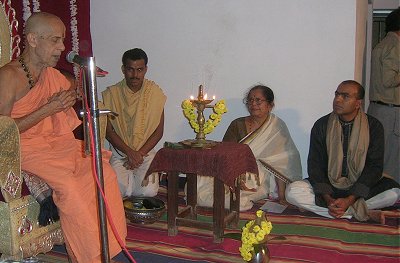The Institution of Mutha
by Vikas Kamat
First Online: November 01, 2006
Page Last Updated: December 07, 2024
Foreigners reading Indian news often run into a word often spelled as mutt, mutha, math, mutha -- that has no equivalent in Western culture. While editing Kamat's Potpourri we roughly approximate the term as monastery, but the institution of muthas is quite unique to India.
A mutha is an ancient institution dating back to the Buddhist period, when the viharas or retreats became centers of educational activity. When Adi Shankaracharya revived Hinduism, he established four fundamental centers of revival and can be argued as the original muthas. This is also the reason why the head of a mutha is sometimes referred with a title of Shankaracharya (example: "Shankaracharya of Kanchi Mutha").
In the course of time, thousands muthas were constructed all over India. Almost every caste, sub-caste, and sect of India has its own mutha, the grandeur and the facility of the monastery depending on the clout and the history of the community. New muthas are built all the time, and serve as centers of spiritual education, community centers, and residential schools (convents for men) preserving an ancient educational system.
Vikas Kamat/Kamat's Potpourri
Gokarn Partagali Jeevotham Mutha
See Also: Mutha as an institution of community education
The Role of Swamiji
A typical mutha is headed by a leader referred to as the Swamiji (pontiff) of that mutha, and as the head of these communities, the swamijis wield considerable political and economic power. The swamijis are ascetics and have no material attachments, but often surrounded by manipulative followers.
In the recent years, many swamijis have broken traditions and have engaged in social causes such as curing of poverty, abolishment of the caste system and social reform. However, we see that many swamijis consider themselves as the protectors of old traditions and are reluctant to participate in social change, and are adamant to protect old traditions.
The swamijis remain apolitical, but their endorsement is considered vital during political campaigns.
The swamijis typically reside in the premises of a mutha and provide encounters (called darshans) to privileged followers. The swamijis are consulted on all important matters involving personal and community interests.
G.L.Kamat/Kamat's Potpourri
Swamiji of Pejawar Mutha at Discourse
See Also: Sages, Sadhus, and Swamis -- A classification of the holy men of India. Also a fascinating potpourri of pictures
Jaina Muthas
The Jains also have muthas in places of Jain pilgrimage. However, the dynamics of a Jaina mutha are different than discussed here. Jain muthas are repositories of ancient archives, manuscripts and are typically run by religious trusts.
© K. L. Kamat

Jain muthas are great sources of art, history, and scholarship
Above: Detail from a fresco, Jaina mutha, Sravanabelagola
![]()
See Also:
-
Hinduism Potpourri -- Hindu mythology, point of views, pictures of deities, sages and stories.

